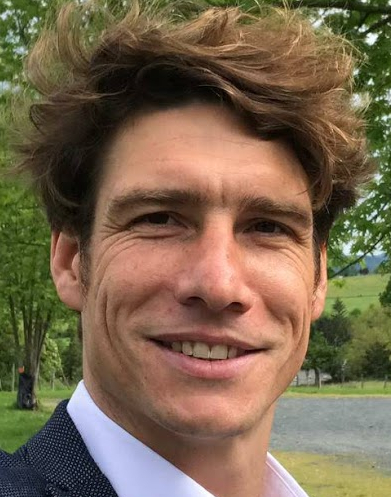Current Research
My current research at Teraki consists of developing ML-based models to improve data quality of remote sensing measurements. In particular, I work towards Advance Driver-Assistance Systems (ADAS) implementation, mostly focused on automotive radar systems and fusion (camera/lidar/GPS/radar) measurements. The understanding of the key physical characteristics of radar sensors allows developing models adapted to the steep improvements in radar technologies.
Former/Ongoing Research
In addition to my current research, I work in searching the optimal conditions for a track cyclist to reduce his aerodynamic drag through the optimal distance between the cyclists and the fabric of their sportswear. This work is done with Philippe Odier as part of the project France 2024, which aims to improve the performance of the French track team in the Olympic Games taking place at Paris in 2024.
I continue to collaborate with subjects such as rotating and stable stratified flows. I worked both, numerical and experimentally, in the question of how the energy is transfer through scales by turbulence in these environments. The main motivation to study this process is given by the fact that both the ocean and the atmosphere are rotating and stratified environments. The multiscale transfer of energy is a key process to improve parametrization of climate model, which need to take into account the physics happening on sub-grid scales. This work is done with Paul Billant and Jean-Marc Chomaz, from LadHyX.
I also work in the study of mixing in stratified turbulence through high resolution DNS with Alex Delache and Louis Gostiaux, from the LMFA at Ecole Centrale de Lyon, and Antoie Venaille from the ENS de Lyon.
I collaborate with my former supervisors Sylvain Joubaud and Philippe Odier in experimental work related to my PhD thesis done at the ENS Lyon. We are working in collaboration with Nelly Pustelnik in developing a variational mode decomposition method for estimating critical reflected internal waves. With Felix Beckebanze we described a theoretical framework for experimental observations of particle transport induced by internal wave beam streaming in lateral boundary layers, in collaboration with Diane Micard.
Detailed research topics
Radar sensors for AD and ADAS
The evolution of Advance Driver and Advance Driver-Assistance Systems relies on the capability to translate complex information of the surroundings of a vehicle into meaningful information. We develop models that interpret radar noisy measurements and transform it into target-recognition, tracking of objects and classification of these objects.

Figure: Multiple sensors identify the surrounding environment of a vehicle, allowing to take the next decision that assures its safety.
Aerodynamics of track cycling
The optimal distance between cyclists is a key characteristics for track racing to avoid accidents and reduce the surface drag generated at high speeds. We studied the connection between cyclist-distance and power injected by the cyclist to analyse the best possible strategy in races. In addition, the texture of the sport-fabric plays a fundamental role in the drag-surface. We perform wind-tunnel measurements over many sport-fabrics to adapt the sportwear according to the part of the body that is covered and the typical speed of the cyclist. The project aims to produce a qualitative improvement in the performance of the french track team in the Olympic games taking place at Paris in 2024.

Figure: (Left) team aligned to reduce air drag. (Right) Different textures in fabric have different effects on surface-drag.
Energy cascade in stratified and rotating flows
Turbulence in the ocean and atmosphere is dominated by stratification and rotation. Understanding how the energy is transported from large eddies to the small dissipative scales would improve the modeling of the unresolved scales in meteorological and oceanic models. We use a stratified tank set on a rotating table and direct numerical simulations to study stratified and rotating turbulence. The turbulence is produced by the interaction of multiple columnar vortices.

Figure: Evolution of the vertical vorticity field obtained from numerical simulations.
The combination of stratification and rotation produces a particular type of turbulence, with a dual cascade of
energy towards the large scales and small scales where the energy is dissipated. The eddies are large (see horizontal plane) but with a small thickness that induces strong shear and the formation of small scales (see vertical plane).
Turbulence mixing in high resolution DNS
Stratified fluids are common to many geophysical and industrial environments. The dynamics of these systems are driven by the complex balance between turbulent decay, buoyancy restoring force and irreversible mixing ; where the local mixing can produce an effect in the global energy budget of the system.
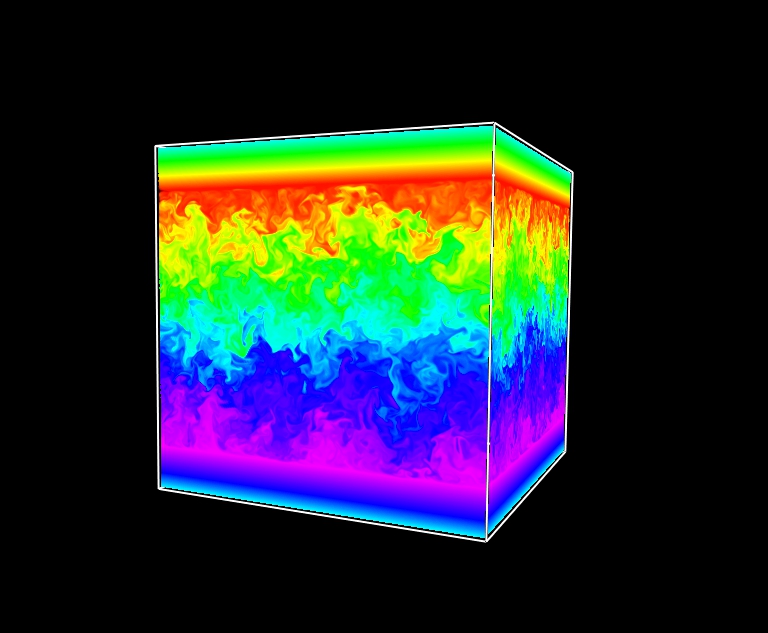
Figure: Snapshot of a 3D buoyancy field of a turbulent decaying flow with initial linear stratification.
In particular, turbulent mixing in the ocean interior plays a crucial role in its global energy budget. This mixing partially drives large scale dynamics, as evidenced in the meridional overturning circulation (Wunsch and Ferrari (2004)). In addition, vertical transport in the ocean is substantial for sequestering large quantities of dissolved greenhouse gases from the atmosphere to the deep ocean. The proportion of energy transferred from turbulent structures to effective mixing is very difficult to estimate through observations (Ivey et al. (2008)). Through measurements in well controlled environements we were able to give better estimation of these quantities.
Internal gravity waves
When difference of density exists within a fluid, it will tend to redistribute driven by the force of gravity so that the lighter fluid remains above the heavier forming a stable stratification profile. This particular configuration will be stable in time and if not perturbed, static. When the fluid is slightly vertically displaced, it will feel a buoyancy restoring force acting in a direction opposite to the displacement. The force will act as a spring, and therefore the fluid will oscillate around an equilibrium position. These oscillations are know as internal gravity waves, which differ from the well known surface waves, as they occur inside the fluid where the density of the fluid changes continuously.
The atmosphere is stratified in temperature, and the ocean is stratified in both salinity and temperature. The main motivation for understanding the dynamics of internal gravity waves is that they occur naturally in these systems. These waves have an effect over the dynamics of stratify systems, and may be taken into account to be able to better predict large scale effects such as transport of energy and matter.
Watch a video of an internal plane wave propagating in experimental conditions here.
Internal waves near-critical reflection
Watch a video of an internal wave near-critical reflection in experimental conditions here.
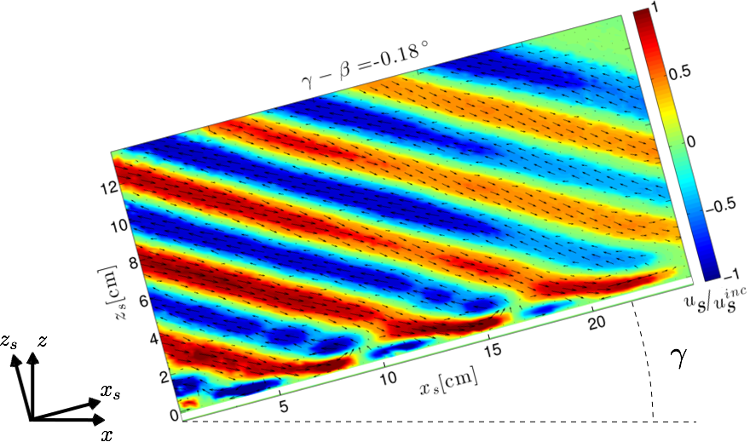
Figure : Velocity field of an internal wave near-critical reflection. The incident wave is coming from left to right, and the generator is located 30 cm from the center of the image.
The peculiar dispersion relation and the nonintuitive relation between group velocity and the wavenumber of internal gravity waves lead to some very unusual physical consequences. In particular, when internal waves are reflected on a sloped boundary the frequency is conserved, and therefore, its angle of propagation. In consequence, nonintuitive effects including reflection, focalization and wave attractors will emerge when internal waves interact with boundaries.
The detailed study of this process is principally motivated by the peculiar characteristics of internal waves reflection that can enhance the shear stress developed near boundaries and therefore generate erosion of particles settle at a boundary.
Many observational studies have been done that indicate that internal gravity waves are a cause of sediment resuspension, as for example Bogucki et al 1997., Quaresma et al. 2007 and Hosegood & van Haren 2004. In every case the capacity of generating sediment transport through the interaction of internal waves over the seafloor is limited by the shear stress generated at the boundary and the physical characteristics of the particles
Transport of particles by internal gravity waves
Oscillating column
Find a video here
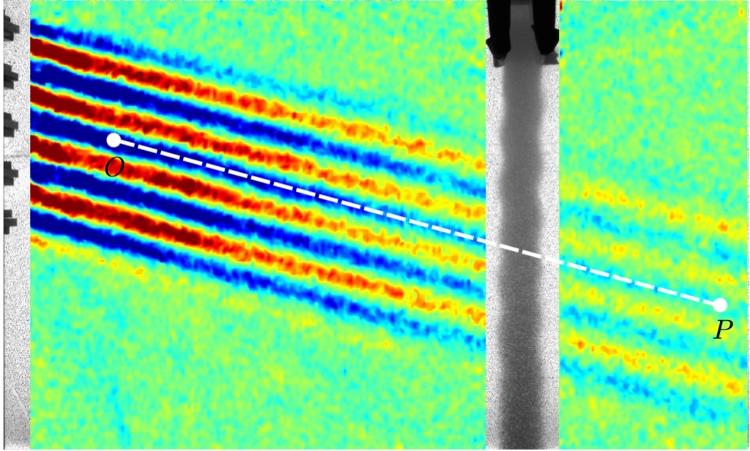
Figure : Internal waves passing through a column of particles in suspension. The boundaries of the column are perturbed by the pass of the wave.
Displaced column
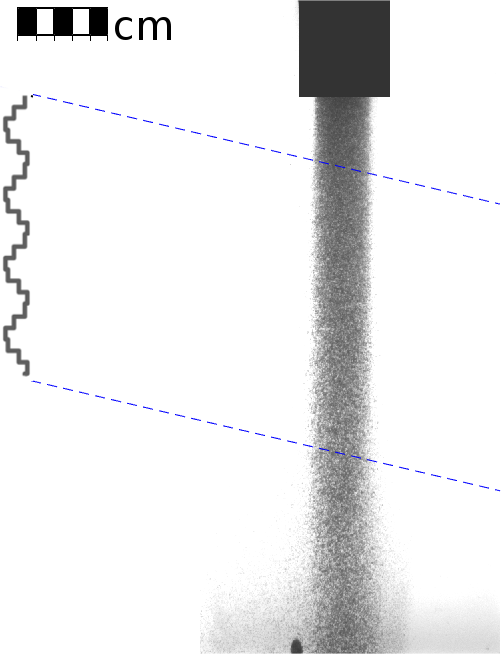
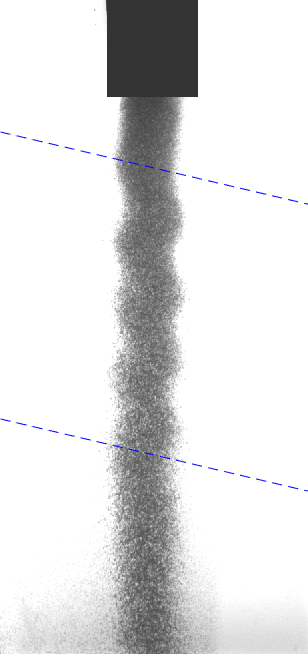
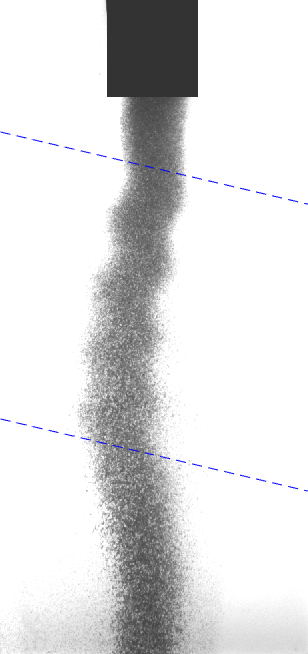
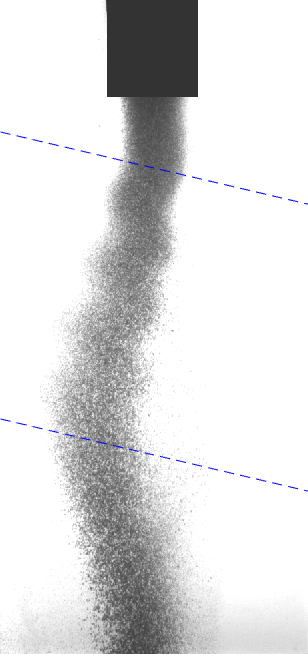
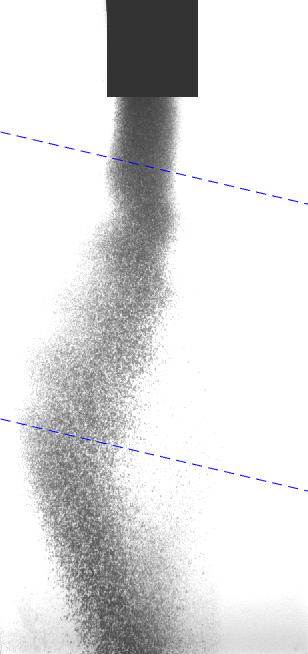
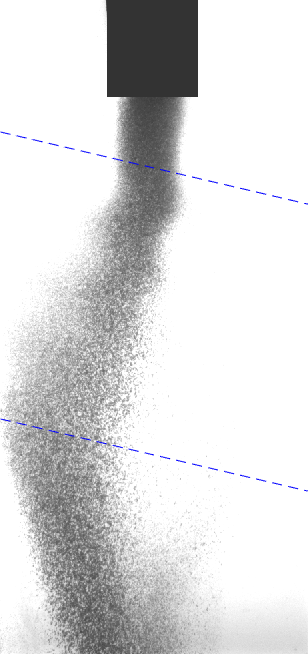
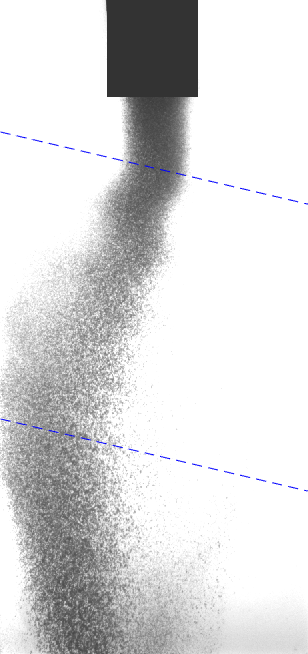
Figure : Snapshots of the front view of a column of particles in suspension in a linear stratified fluid. Time evolves from up-left to down-right. The snapshots are taken every 5 periods of the internal waves (T=25 s). The wave generator is turned on for the first snapshot. With blue dashed lines is indicated the borders of the wave beam. The column is displaced towards the wave generator.
